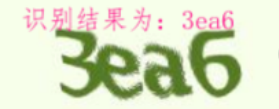我佛了!用 KNN 实现验证码识别,又 Get 到一招
作者 | 李秋键
编辑 | Carol
题图 | 视觉中国
出品| CSDN(ID:CSDNnews)


实验前的准备


训练模型的搭建
1、获取切割字符轮廓:
#定义函数get_rect_box,目的在于获得切割图片字符位置和宽度
def get_rect_box(contours):
print(
"获取字符轮廓。。。")
#定义ws和valid_contours数组,用来存放图片宽度和训练数据集中的图片。如果分割错误的话需要重新分割
ws = []
valid_contours = []
for contour
in contours:
#画矩形用来框住单个字符,x,y,w,h四个参数分别是该框子的x,y坐标和长宽。因
x, y, w, h = cv2.boundingRect(contour)
if w <
7:
continue
valid_contours.append(contour)
ws.append(w)
#w_min是二值化白色区域最小宽度,目的用来分割。
w_min =
min(ws)
# w_max是最大宽度
w_max =
max(ws)
result = []
#如果切割出有
4个字符。说明没啥问题
if
len(valid_contours) ==
4:
for contour
in valid_contours:
x, y, w, h = cv2.boundingRect(contour)
box = np.int0(
[[x,y], [x+w,y], [x+w,y+h], [x,y+h]])
result.append(box)
# 如果切割出有
3个字符。参照文章,中间分割
elif
len(valid_contours) ==
3:
for contour
in valid_contours:
x, y, w, h = cv2.boundingRect(contour)
if w == w_max:
box_left = np.int0(
[[x,y], [x+w/2,y], [x+w/2,y+h], [x,y+h]])
box_right = np.int0(
[[x+w/2,y], [x+w,y], [x+w,y+h], [x+w/2,y+h]])
result.append(box_left)
result.append(box_right)
else:
box = np.int0(
[[x,y], [x+w,y], [x+w,y+h], [x,y+h]])
result.append(box)
# 如果切割出有
3个字符。参照文章,将包含了
3个字符的轮廓在水平方向上三等分
elif
len(valid_contours) ==
2:
for contour
in valid_contours:
x, y, w, h = cv2.boundingRect(contour)
if w == w_max
and w_max >= w_min *
2:
box_left = np.int0(
[[x,y], [x+w/3,y], [x+w/3,y+h], [x,y+h]])
box_mid = np.int0(
[[x+w/3,y], [x+w*2/3,y], [x+w*2/3,y+h], [x+w/3,y+h]])
box_right = np.int0(
[[x+w*2/3,y], [x+w,y], [x+w,y+h], [x+w*2/3,y+h]])
result.append(box_left)
result.append(box_mid)
result.append(box_right)
elif w_max < w_min *
2:
box_left = np.int0(
[[x,y], [x+w/2,y], [x+w/2,y+h], [x,y+h]])
box_right = np.int0(
[[x+w/2,y], [x+w,y], [x+w,y+h], [x+w/2,y+h]])
result.append(box_left)
result.append(box_right)
else:
box = np.int0(
[[x,y], [x+w,y], [x+w,y+h], [x,y+h]])
result.append(box)
# 如果切割出有
3个字符。参照文章,对轮廓在水平方向上做
4等分
elif
len(valid_contours) ==
1:
contour = valid_contours[
0]
x, y, w, h = cv2.boundingRect(contour)
box0 = np.int0(
[[x,y], [x+w/4,y], [x+w/4,y+h], [x,y+h]])
box1 = np.int0(
[[x+w/4,y], [x+w*2/4,y], [x+w*2/4,y+h], [x+w/4,y+h]])
box2 = np.int0(
[[x+w*2/4,y], [x+w*3/4,y], [x+w*3/4,y+h], [x+w*2/4,y+h]])
box3 = np.int0(
[[x+w*3/4,y], [x+w,y], [x+w,y+h], [x+w*3/4,y+h]])
result.extend([box0, box1, box2, box3])
elif
len(valid_contours) >
4:
for contour
in valid_contours:
x, y, w, h = cv2.boundingRect(contour)
box = np.int0(
[[x,y], [x+w,y], [x+w,y+h], [x,y+h]])
result.append(box)
result = sorted(result, key=lambda x: x[
0][
0])
return result
def process_im(im):
rows, cols, ch = im.shape
#转为灰度图
im_gray = cv2.cvtColor(im, cv2.COLOR_BGR2GRAY)
#二值化,就是黑白图。字符变成白色的,背景为黑色
ret, im_inv = cv2.threshold(im_gray,
127,
255,cv2.THRESH_BINARY_INV)
#应用高斯模糊对图片进行降噪。高斯模糊的本质是用高斯核和图像做卷积。就是去除一些斑斑点点的。因为二值化难免不够完美,去燥使得二值化结果更好
kernel =
1/
16*np.array([[
1,
2,
1], [
2,
4,
2], [
1,
2,
1]])
im_blur = cv2.filter2D(im_inv,
-1,kernel)
#再进行一次二值化。
ret, im_res = cv2.threshold(im_blur,
127,
255,cv2.THRESH_BINARY)
return im_res
3、切割字符:
#借助第一个函数获得待切割位置和长宽后就可以切割了
def split_code(filepath):
#获取图片名
filename = filepath.split("/")[-1]
#图片名即为标签
filename_ts = filename.split(".")[0]
im = cv2.imread(filepath)
im
_res = process_im(im)
im2, contours, hierarchy = cv2.findContours(im
_res, cv2.RETR_EXTERNAL, cv2.CHAIN
_APPROX_SIMPLE)
#这里就是用的第一个函数,获得待切割位置和长宽
boxes = get
_rect_box(contours)
#如果没有区分出四个字符,就不切割这个图片
if len(boxes) != 4:
print(filepath)
# 如果区分出了四个字符,说明切割正确,就可以切割这个图片。将切割后的图片保存在char文件夹下
for box in boxes:
cv2.drawContours(im, [box], 0, (0,0,255),2)
roi = im_res[
box[0][
1]:box[
3][
1], box[
0][
0]:box[
1][
0]]
roistd = cv2.resize(roi, (30, 30))
timestamp = int(time.time() * 1e6)
filename = "{}.jpg".format(timestamp)
filepath = os.path.join("char", filename)
cv2.imwrite(filepath, roistd)
#cv2.imshow("image", im)
#cv2.waitKey(0)
#cv2.destroyAllWindows()
# split all captacha codes in training set
#调用上面的split_code进行切割即可。
def split_all():
files = os.listdir(TRAIN_DIR)
for filename in files:
filename_ts = filename.split(".")[0]
patt = "label/{}
_*".format(filename_ts)
saved_chars = glob.glob(patt)
if len(saved_chars) == 4:
print("{} done".format(filepath))
continue
filepath = os.path.join(TRAIN_DIR, filename)
split_code(filepath)

#用来标注单个字符图片,在label文件夹下,很明显可以看到_后面的就是标签。比如图片里是数字
6,_后面就是
6
def label_data():
files =
os.listdir(
"char")
for filename
in files:
filename_ts = filename.split(
".")[
0]
patt =
"label/{}_*".
format(filename_ts)
saved_num =
len(glob.glob(patt))
if saved_num ==
1:
print(
"{} done".
format(patt))
continue
filepath =
os.
path.join(
"char", filename)
im = cv2.imread(filepath)
cv2.imshow(
"image", im)
key = cv2.waitKey(
0)
if key ==
27:
sys.
exit()
if key ==
13:
continue
char = chr(key)
filename_ts = filename.split(
".")[
0]
outfile =
"{}_{}.jpg".
format(filename_ts,
char)
outpath =
os.
path.join(
"label", outfile)
cv2.imwrite(outpath, im)
#和标注字符图反过来,我们需要让电脑知道这个字符叫啥名字,即让电脑知道_后面的就是他字符的名字
def analyze_label():
print(
"识别数据标签中。。。")
files =
os.listdir(
"label")
label_count = {}
for filename
in files:
label = filename.split(
".")[
0].split(
"_")[
1]
label_count.setdefault(label,
0)
label_count[label] +=
1
print(label_count)
#训练模型,用的是k相邻算法
def get_code(im):
#将读取图片和标签
print("读取数据集和标签中。。。。")
[samples, label
_ids, id_label
_map] = load_data()
#k相邻算法
print("初始化中...")
model = cv2.ml.KNearest_create()
#开始训练
print("训练模型中,请等待!")
model.train(samples, cv2.ml.ROW
_SAMPLE, label_ids)
#处理图片。即二值化和降噪
im
_res = process_im(im)
#提取轮廓
im2, contours, hierarchy = cv2.findContours(im
_res, cv2.RETR_EXTERNAL, cv2.CHAIN
_APPROX_SIMPLE)
#获取各切割区域位置和长宽
boxes = get
_rect_box(contours)
#判断有没有识别出4个字符,如果没有识别出来,就不往下运行,直接结束了
if len(boxes) != 4:
print("cannot get code")
result = []
#如果正确分割出了4个字符,下面调用训练好的模型进行识别。
for box in boxes:
#获取字符长宽
roi = im_res[
box[0][
1]:box[
3][
1], box[
0][
0]:box[
1][
0]]
#重新设长宽。
roistd = cv2.resize(roi, (30, 30))
#将图片转成像素矩阵
sample = roistd.reshape((1, 900)).astype(np.float32)
#调用训练好的模型识别
ret, results, neighbours, distances = model.findNearest(sample, k = 3)
#获取对应标签id
label_id = int(results[0,0])
#根据id得到识别出的结果
label = id
_label_map[label_id]
#存放识别结果
result.append(label)
return result

if __name__ ==
"__main__":
file=os.listdir(
"test")
filepath=
"test/"+file[
4]
im = cv2.imread(filepath)
preds = get_code(im)
preds=
"识别结果为:"+preds[
0]+preds[
1]+preds[
2]+preds[
3]
print(preds)
canny0 = im
img_PIL = Image.fromarray(cv2.cvtColor(canny0, cv2.COLOR_BGR2RGB))
myfont = ImageFont.truetype(
r'simfang.ttf',
18)
draw = ImageDraw.Draw(img_PIL)
draw.text((
20,
5), str(preds), font=myfont, fill=(
255,
23,
140))
img_OpenCV = cv2.cvtColor(np.asarray(img_PIL), cv2.COLOR_RGB2BGR)
cv2.imshow(
"frame", img_OpenCV)
key = cv2.waitKey(
0)
print(filepath)

作者简介:
李秋键,CSDN博客专家,CSDN达人课作者。硕士在读于中国矿业大学,开发有taptap竞赛获奖等等。
更多精彩推荐
☞5 月编程语言排行榜:C 重回第一,今年编程语言名人堂冠军还会是它吗?| 原力计划
![]()
你点的每个“在看”,我都认真当成了喜欢
登录查看更多
相关内容
专知会员服务
24+阅读 · 2020年4月4日
专知会员服务
20+阅读 · 2020年1月26日
Arxiv
21+阅读 · 2018年12月25日
Arxiv
9+阅读 · 2018年3月14日
Arxiv
7+阅读 · 2018年2月3日








